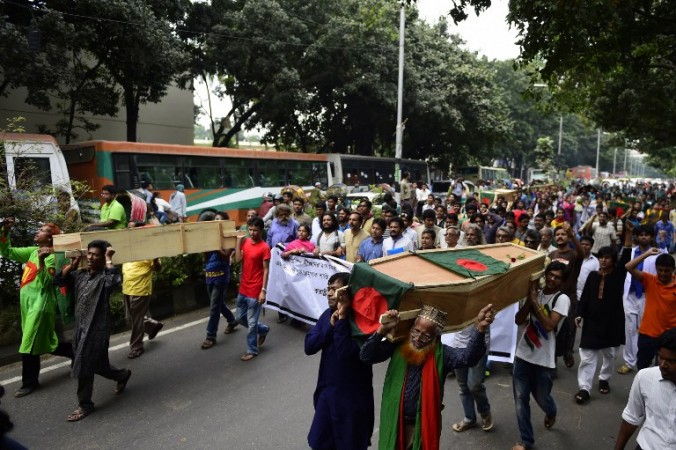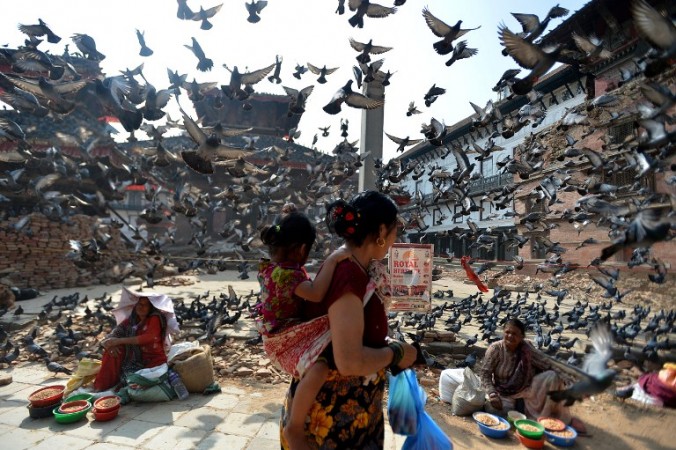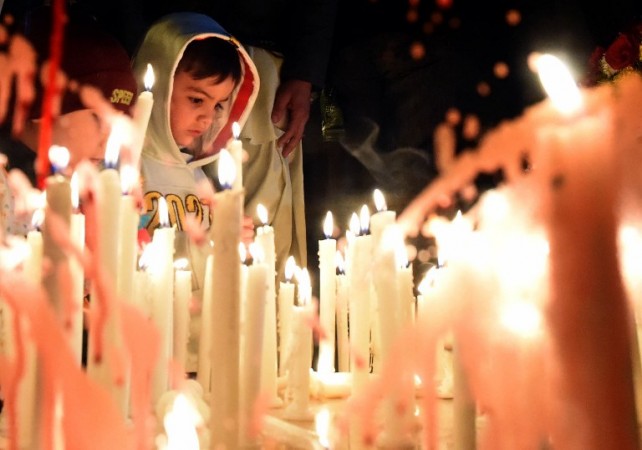The Road to Resilience: Overview

Bangladeshi activists shout slogans as they march in the street with mock coffins, that symbolize the deaths of secular publishers and bloggers, in Dhaka on November 5, 2015. Secular activists marched with mock coffins to protest the recent murder of a publisher and attempted murder of writers and bloggers that have been claimed by Islamic extremists. Photo: Munir uz ZAMAN / AFP
Towards the end of the year under review, the editor public spirited journalists, some of whom have been subject to of a Bangla-language LBGTI magazine Roopbaan was hacked and shot to death in his own home, a victim of homophobia and violent intolerance of secular thought. His brutal killing, for which the IS has claimed responsibility, follows just weeks after the gruesome hacking to death of a young activist in the cause of a new campaign of “free thinking” in Bangladesh. Killed as he walked home in the capital city of Dhaka one evening, he was the seventh blogger to suffer fatal assault over the past three years. The killings left little room for ambiguity about a systematic campaign of retaliation against youthful activism over the blogosphere and social media against the restraints of orthodoxy.
At the same time, in Bangladesh, an editor who was for long tarred as an accessory of the religious parties continues to languish in prison despite a bail order issued by the country’s highest bench. And other editors and public gures who have spoken up for the cause of secularism, are targeted in mass litigation by activists of the ruling party, seemingly with no motive other than extinguishing all sources of public criticism of the government in power. India had an exceptionally bad year in terms of the risks involved in journalism. An unprecedentedly high number of journalists were killed, several identi ably in retaliation for their professional work. There were also numerous arrests on charges brought under special security laws in regions of insurgency and unrest. These arrests have been read by local press freedom workers as transparent acts of vendetta against critical and custodial torture.
Pakistan had a relatively better year in terms of journalists’ safety, but only in relation to the dismal record of the preceding fteen years. The insurgency in Balochistan province continued to pose severe challenges, with a state of lawlessness becoming increasingly the norm in the ongoing war of attrition between armed militants and the security forces. Elsewhere in the country, journalism continued to suffer from all the difficulties of a country caught in the vortex of a global war. A new resolve was evident in Pakistan’s powerful military establishment to take on armed militants within. As part of that campaign, advisories are regularly issued to media organisations about appropriate norms to be followed in coverage of army engagements with outlawed militant groups. These have been seen as unseemly intrusions into journalistic autonomy. And even media platforms that seek to comply, and the task is rendered difficult by the fact that most militant groups have their political wings which have been in some part proscribed, but continue to operate in the open.
In Pakistan, a rarely applied clause of the law on free speech, which allows for restraints in the interests of friendly relations with a foreign power, was dusted up and applied. The matter involved media reporting and commentary on Saudi Arabia, one of Pakistan’s closest allies, now embroiled in a war in Yemen that is rapidly turning into a military quagmire.
The army has ambiguous rules of engagement in these matters, often preferring not to directly engage with political groups defying of cial bans. The media often gets caught in between. Militant groups and their political wings take media caution to be active hostility or partisanship on behalf of the army, and miss no opportunity to attack journalists performing their duty. Some of this dynamic was in evidence in February and March, when crowds came out on the streets in some of Pakistan’s cities after the execution of the convicted assassin of Salman Taseer, governor of Punjab province in 2011. Taseer was also a media owner of some signi cance and was killed in evident retaliation for his public expressions of sympathy for a poor woman facing charges under the country’s oppressive blasphemy law.
Security anxieties were a constant in several countries. In India, news channels were issued notice asking for reasons why they should not be held legally liable for coverage of the prelude and aftermath of the execution of a person convicted for a 1993 serial bombing in the city of Mumbai. Campus unrest in some of the most renowned universities of the country brought questions of loyalty to the security agencies and their agendas to the forefront, provoking a bitter rift within the media and questions about the credibility of some among them. Ethical issues were raised in debates within professional circles and the large and growing number of social media users in India, as norms of objectivity and distance in covering matters portrayed to involve national security interests came under assault.

Flying pigeons pass over Nepalese street vendors near the earthquake damaged UNESCO World Heritage Site, Durbar Square in Kathmandu on May 20, 2015. Nearly 8,500 people have now been confirmed dead in the disaster, which destroyed more than half a million homes and left huge numbers of people without shelter with just weeks to go until the monsoon rains. Photo: ISHARA S. KODIKARA / AFP
Events in Nepal were overshadowed by the devastating earthquakes in the east of the country in April and May 2015. One journalist was killed, several were injured and media organisations without exception had to incur major costs in restoring their operations after the devastation. The long deferred task of arriving at a consensus on the shape of the Nepali republic was successfully consummated, but only at the cost of triggering a fresh wave of turmoil in the country’s southern plains. India too expressed its displeasure at the new constitutional order with what was euphemistically called an “informal blockade” on trade and transit into Nepal. There was a longish period of scarcity of essential commodities in the landlocked country, but a mobilization of a new fighting spirit in which the Nepali media played a part.
The situation in Sri Lanka marks a bright spot, though not unequivocally so. The end of the civil war in 2009 brought about little improvement in the status of journalists since the overwrought mood of triumphalism meant that long overdue processes of reconciliation and accountability were given short shrift. When Mahinda Rajapaksa amended the constitution to remove any term limits over the all powerful executive presidency in Sri Lanka, there seemed few avenues open for restoring long-lost freedoms. The defeat of the Rajapaksa autocracy in the presidential elections in January 2015 and subsequent parliamentary polls opened the pathway to a new order for journalists and other human rights defenders.
There is an unprecedented situation in Sri Lanka in that political parties used more to being in opposition, are today holding the reins of power in a coalition. There has been a phase of cohabitation before, with presidency and prime ministership split, but this was ended when the two parties began pulling in different directions in their approach to the island nation’s long-running ethnic conflict. The end of that phase of co-operation paved the way for the arrival of the Rajapaksa autocracy, and the brutality of the last phase of the war which was accompanied by a severe curtailment of civil liberties all over Sri Lanka.
Websites have made a comeback to Sri Lanka after being forced into exile during the last months of the war and the subsequent phase of unbridled triumphalism. An irritant has arisen in the shape of the government’s insistence that news websites should be registered. The Sri Lanka Press Council, based on a legislation passed in the 1970s, continues to exist and to enjoy the draconian powers of ordering journalists jailed and media outlets shut down. The industry-sponsored independent grievance redress mechanism, the Press Complaints Commission of Sri Lanka, continues to function though in a rather lackadaisical manner. Leadership positions in state-owned media were reshuffled following the power shift of 2015 and loyalists of the current dispensation placed in authority. The transition to public service media which journalists’ bodies and activists in Sri Lanka have long been advocating, remains a distant prospect. Journalists in the northern province of the country, where the last and most brutal phases of the civil war were fought, remain embattled and often report being watched on by the security and intelligence agencies.
Older practices of public abuse of journalists by political gures have occasionally been manifest. But on the bright side, a number of international journalists denied entry after being declared persona non grata for critical reporting and documentation on the human rights costs of the civil war, have been allowed back in. An international press freedom mission visited Sri Lanka during the period under review and was granted unfettered access. A comprehensive set of recommendations has been submitted, but not acted upon as yet. In one of its most significant acts of reconciliation, the government has announced that all journalists who suffered injury or any other form of harm from arbitrary actions by state authorities between 2005 and 2015 could submit a claim for reparations.
Journalism and media in Afghanistan continue to suffer due to operating in one of the main theatres of a global war. Warnings by insurgent groups irked by critical media reporting and commentary are frequent. The recurrent bomb attacks in the country’s main urban centres continue to take a toll in lives and journalistic morale. And with the political players who have committed to the democratic process being divided among themselves, no clear consensus has emerged on the need to preserve free media as a cross-partisan commitment.
In the Republic of the Maldives, political discord exacts a price on free media practice. The jailing of former President Mohamed Nasheed on terrorism charges has deepened the polarization between the old order and those empowered by the 2008 elections which brought him to power. There have since been numerous executive and judicial acts which have alienated sections of the republic’s media community, such as a court ordered closure of a newspaper, the nomination of partisans of the ruling party to the ostensibly independent broadcasting commission. Journalist Ahmed Rilwan, believed abducted in August 2014, remains missing.
Corruption allegations against the incumbent president have elicited a vengeful response, with moves afoot to criminalize the offence of defamation. The reversion to an older punitive regime is regarded with alarm, since the decriminalization of defamation, achieved following Nasheed’s election in 2008, was a major landmark in press freedom in the Maldives. Early in April 2016, a demonstration by journalists against the various fetters upon their freedom was set upon by police in what was regarded as a disproportionate application of force. Four journalists from a pro-Nasheed TV channel were subsequently charged with criminal offences ranging from rioting to obstructing the police in the discharge of their duties.

Pakistani civil society activists light candles in Quetta on December 16, 2015, on the first anniversary of attack on Army Public School Peshawar. Pakistan’s leader, speaking beneath portraits of children killed by Taliban bullets, called for vengeance as the country marked the first anniversary of a school massacre that killed 151 people in its worst-ever extremist attack. Photo: Banaras KHAN / AFP
In the Himalayan kingdom of Bhutan, the transition to a constitutional monarchy with a parliamentary government proceeds with accustomed tranquillity. Media development is limited by the small market and the limited advertising budgets deployed. Government funding and some degree of international donor support, have kept the media scenario lively with not a single outlet shutting shop. This is regarded by the country’s journalists as an achievement in itself, but the dependence on state funding restricts freedom. And with the government being a major advertiser a clear policy on allocation of ads between media outlets is seen as an imperative for relative media autonomy. Social media has been a major platform for exchange of news and views, but in a small community, the need for voluntary norms of ethical conduct has been strongly felt.
Most countries have recognized the value of the right to information (RTI) in principle, though legislation remains lacking in Sri Lanka, Bhutan, Afghanistan and the Maldives. The Pakistan province of Khyber Pakhtunkhwa sought to introduce amendments in its RTI law to protect legislators from full disclosure, but had to withdraw following protests.
In the province of Punjab, follow up in terms of empowering and funding the agencies of transparency, has been lacking, though public pressure is building up for the government to follow up its legislation with appropriate action on the ground.
Regulatory efforts especially in relation to the electronic media and the internet, remained a challenge in all countries. In Pakistan, the introduction of a draft bill on the prevention of ‘electronic crimes’ was seen as a possible deterrent to free speech over the internet. India’s telecoms regulator though, struck an important blow for net neutrality, prohibiting a two-speed or a differentially-priced internet at a time when several service providers were gearing up to provide a free channel for certain kinds of content.
The struggle against impunity continued. SAMSN affiliates in India have campaigned actively and at all levels of the political hierarchy for a special law protecting journalists.
In Pakistan, one conviction was secured in a journalist’s murder, but a larger opportunity was squandered. A judicial commission appointed to probe a near-lethal attack on one of the country’s most high pro le media personalities in 2014, failed repeatedly to meet, missed all deadlines and was in every other way complete opaque to public scrutiny.
The struggle for decent wages and working conditions continued, though with only sporadic successes in India and Pakistan. Nepal’s journalists secured a doubling of their minimum wage, after representations before the empowered committee. Implementation remains a challenge and SAMSN affiliates in Nepal have begun a targeted campaign focused on particular media organisations, to ensure their rights.
Resources
- IFJ South Asia Media Bulletin, February 2023 02/15/2023 Download
- IFJ South Asia Media Bulletin, January 2023 01/18/2023 Download
- Nepal Press Freedom report 2022 01/03/2023 Download

